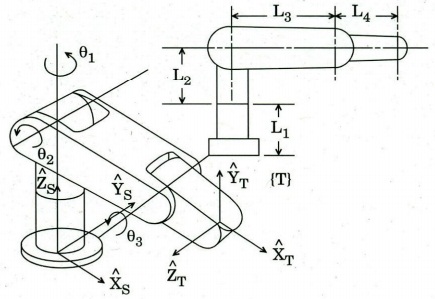(HOT) UPSC Current Affairs 2025 PDF
NEW! The Gist (NOV-2025) | E-BOOKS
(Download) UPSC IES Exam Paper - 2018 "Mechanical Engineering Paper - 2"
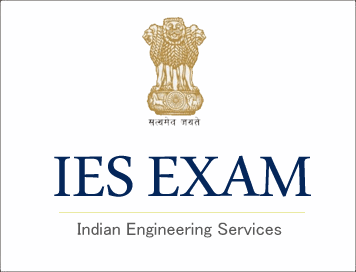
(Download) UPSC IES Exam Paper - 2018 "Mechanical Engineering Paper - II"
Exam Name: Engineering Services Exam (IES)
Paper : Mechanical Engineering Paper - II
Year: 2018
File Type: PDF
MECHANICAL ENGINEERING
PAPER-2
Time Allowed : Three Hours
Maximum Marks : 300
QUESTION PAPER SPECIFIC INSTRUCTIONS
Please read each of the following instructions carefully before attempting questions
There are EIGHT questions divided in two Sections.
Candidate has to attempt FIVE questions in all.
Question Nos. 1 and 5 are compulsory and out of the remaining, any THREE are to be attempted choosing at least ONE from each Section.
The number of marks carried by a question/part is indicated against it.
Wherever any assumptions are made for answering a question, they must be clearly indicated.
Diagrams/Figures, wherever required, shall be drawn in the space provided for answering the question itself.
Unless otherwise mentioned, symbols and notations have their usual standard meanings.
Psychrometric Chart is given in Page No. 8.
Attempts of questions shall be counted in sequential order. Unless struck off, attempt of a question shall be counted even if attempted partly.
Any page or portion of the page left blank in the QCA Booklet must be clearly struck off.
Answers must be written in ENGLISH only.
SECTION-A
Q1. (A) (i) A flue pipe in a furnace system is rigidly attached to the furnace wall at P, as shown in the figure below. Compute the moments at points P1 and P2 when a force of 300 N is acting at the end of the pipe.

(ii) Consider a solid block of mass 'm' resting on a horizontal surface. When the mass is subjected to a horizontal force 'P' it will experience a frictional force resisting the motion. Draw and show the variation of frictional force F vs. applied force P even if it continues to shift from no motion (static friction) domain to motion domain (kinetic friction).

(B) Draw and show the bending moment diagram and shear force diagram of a beam of length 'L' subjected to a uniformly distributed loading for the following boundary conditions:
(i) Cantilever beam
(ii) Simply supported beam
(iii) Beam with both ends fixed
(iv) Beam with one end simply supported and a propped support at 1/4th L from
the other end
(C) (i) Distinguish and differentiate between machine and mechanism. Define the term Inversion of a kinematic chain.
(ii) Discuss about the possible inversions (with figures) of a four bar chain.
(D) Derive the equation for the resultant unbalanced force at any instant of a reciprocating mass of a slider crank mechanism.
(E) In a pair of mating spur gears, the pitch-diameter of smaller gear is 120 mm. The pair is of standard gear involute having module as 8. If the transmission ratio between the gears is 4:3, then find out
(i) Number of teeth on gear,
(ii) Number of teeth on pinion,
(iii) Addendum,
(iv) Dedendum,
(v) Whole depth, and
(vi) Clearance.
Q2. (A) Compute the velocity and acceleration of the slider
in the quick return mechanism shown in the figure below, if the crank rotates at
30 rpm.
(B) (i) Draw and show the variation of centrifugal force and controlling force of a governor.
(ii) Define Stability, Sensitivity, Isochronism governor. and Hunting in a
(C) The data for 2 sets of spur gears are given below :

Check for the occurrence of Interference. If it occurs, what is the pressure angle to correct it?
(D) (i) A single degree of freedom system is subjected to an external harmonic force F(t) = F, sin wit. Define magnification factor (MF) and plot it as a function of damping factor as it varies with respect to frequency ratio.
(ii) A machine part having a mass of 2.5 kg vibrates in a viscous medium. A harmonic exciting force of 30 N acts on the part and causes a resonant amplitude of 14 mm with a period of 0.22 seconds. Find the damping coefficient.
Q3. (A) (i) Define, discuss and differentiate :
(A) Centers of mass vs Centroid
(B) Mass Moment of Inertia vs Area moment of inertia
(C) Centroid of Lines, Areas and Volumes
(ii) Locate the centroid of a circular arc as shown in the figure below:
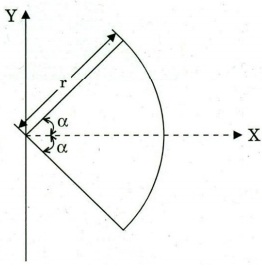
(B) Draw the Shear Force Diagram and Bending Moment Diagram of a simply supported beam carrying a uniformly varying load from zero at one end to 'w' per unit length at the other end. Compute the maximum B.M and its location.
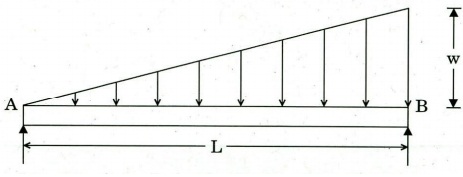
(C) (i) Three children are standing on a 5 m x 5 m raft as shown in the figure below :

The weights of the children at points A, B and C are 375 N, 260 N and 400 N, respectively. Determine the magnitude and the point of the resultant of their weights.
(ii) In a two dimensional system acted by various forces as specified below :
-
forces are collinear
-
forces are concurrent at a point
-
forces are parallel to each other
-
general
Draw the free body diagram and equation defining them.
(D) Two shafts of the material and of same lengths are subjected to same torque. If the first is of a solid circular section and the second shaft is of hollow circular section, whose internal diameter is 2/3 of the outside diameter and the maximum shear stress developed in each shaft is the same, compare weights of the shafts.
Q4. (A) Differentiate between uniform pressure and uniform wear theory. What would you conclude, about the effect over friction radius, under following two conditions of operation of a clutch, considering uniform pressure theory and uniform wear theory in both the conditions.
(i) Outer Radius - 100 mm
Inner Radius – 90 mm
(ii) Outer Radius – 100 mm
Inner Radius - 25 mm
(B) Design a flywheel for a single cylinder four-stroke diesel engine, made of cast iron, whose allowable strength is 20 MN/m2. The engine is running at a speed of 1400 r.p.m. and producing 5 kW of power. Maximum peripheral speed of the flywheel may be up to 24 m/sec. Coefficient of fluctuation of energy may be taken as 2.2 and coefficient of speed fluctuation as 0.015. Density of cast iron may be taken as 7000 kg/m3. (The effect of overhang of the flywheel on the end may be neglected.)
(C) Three M20 bolts are used to connect a steel plate with a channel section structural member as shown in the figure. The material of the bolt is 50C4 with o, = 660 MPa and oy = 460 MPa. Determine the factor of safety, if the plate carries a load of 25,000 N at its end. Take area of M20 bolts as 245 mm2

Study Material for IAS (UPSC) General Studies Pre. Cum Mains
SECTION B
5. (A) Define unit cell of a space lattice. Derive the effective number of lattice points in the unit cell of cubic lattices. Calculate the packing efficiency and density of silicon which has diamond cubic structure. Use the following properties for silicon :
Atomic No. = 14
Atomic Mass Unit = 1.66 × 10-27 kg
Lattice Parameter = 5.431 x 10-10 m
Assume radius of Si atom in diamond cubic structure to be (Ö3/8)times the lattice parameter.
(B) Define a 'sensor'. Describe the following performance terms related to a sensor:
(i) Accuracy
(ii) Sensitivity
(iii) Hysteresis error
(iv) Non-linearity error
(v) Resolution
(C) What is the significance of Ernst and Merchant theory in study of mechanics of chip formation in machining operation ? Using its principle, find out the cutting force, thrust force and shear force applied in a machining operation of a cast iron component, whose ultimate strength is 370 MPa and coefficient of friction between tool and chip is 0.55. The depth of cut is 3.5 mm and feed of cut is 0.3 mm. The normal rake angle and principal cutting edge angle are 12° and 30°, respectively
(D) What are the important ingredients (elements) of an FMS ? In what kind of manufacturing scenario, is it best to be employed ? For the same case, or in general, enlist its four major advantages.
(E) A project has seven activities, each with totally deterministic completion time and involved cost. These activities with other related data are as given in the table below.
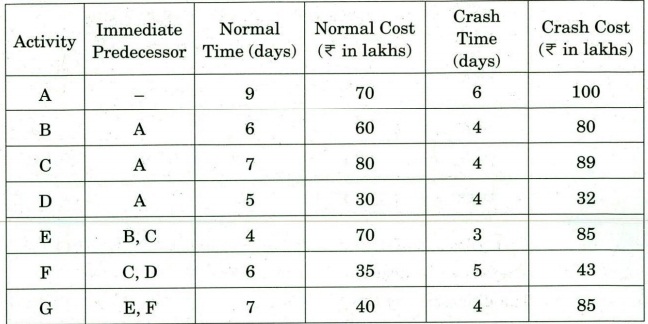
Each day of early completion of the project yields saving in administrative cost of 2 lakhs and an additional profit of 5 lakhs. Find out the most economical completion time for the project assuming that crashing cost increases linearly with the decrease in activity duration.
Q6. (A) Define 'phase of a system. Mention Gibbs' phase rule and describe the terms in it. Lead and tin have complete liquid solubility and limited solid solubility. Describe the binary phase diagram involving lead and tin. Explain how this phase diagram helps in identifying composition for electrical solder and plumbing solder.
(B) Describe different heat treatment processes of steels with the help of Iron-Carbon equilibrium diagram. On a T-T-T diagram of plain carbon steel, show the following processes and the resulting phases :
-
Water quench to room temperature
-
Hot quench to 300°C, hold for 5 h and water quench
-
Hot quench to 450°C, hold for 1 h and water quench
On the same T-T-T diagram, show the Austempering and Martempering
(C) A manufacturer of textile dyes can use two different processing routes for producing a particular type of dye. Route 1 uses drying press A, and route 2 uses drying press B. Both routes require the same mixing vat to blend chemicals for the dye before drying. The following table shows the time requirements and capacities of these processes :

Each kilogram of dye processed using route 1 uses 20 litres of chemicals, whereas each kilogram of dye processed on route 2 uses only 15 litres. The difference results from differing yield rates of the drying presses. Consequently, the profit per kilogram processed on route 1 is 500 and on route 2 is 650. A total of 450 litres of input chemicals is available. Write the constraints and objective function to maximize profits. Use the graphic method to find the optimal solution, and also non-utilised part of the processes.
(D) A plant is capable of producing 10,000 units of an item in a year. Demand of this item is not increasing and is going to remain constant in future as well. Annual demand of this item is going to stay at 5,000 units. Set-up cost of * 10,000 has to be incurred every time a new batch of this item is launched for production. Each unit of the item, after its manufacture, costs 320. Inventory carrying cost of the finished item is 10% of its cost when held in stock for one year.
Determine the economic production lot size and the number of batches to be taken each year for production assuming all these batches are to be of equal size. Also determine inventory cycle and production cycle (the time during which the plant shall be busy in an inventory cycle for producing the item) length.
Q7. (A) Time. between failure of a machine is known to be exponential with mean value of 9000 hours (about 1 year of operation). The company issues one-year warranty on this machine.
What are the chances that a breakdown repair will be required from the company during the warranty period ?
The machine has run without fail for 4,500 hours. What are the further chances of breakdown repair under warranty period ?
(B) (i) Explain in brief, about the geometric characteristics of Flatness, Straightness, Roundness, Profile of a surface and Angularity. Also, show the symbols by which these are represented.
(ii) What are the different zones of an electric àrc, generated for the electric arc welding process ? Also explain their characteristics.
(C) (i) What are the various forging defects, which are likely to take place, because of the faulty forging process design ? Explain about any five in brief.
(ii) What is Gating ratio ? What is its importance for successful casting operation ? Also, explain its types with their respective suitabilities, with examples.
Q8. (A) (i) What is a Gating System ? What are the different elements of it ? Explaining 'Aspiration Effect', discuss which of the elements of the Gating System is mostly affected with it and what measures are taken to avoid it.
(ii) State how Standard Tolerance Grade, position of Tolerance zone, Upper deviation and Lower deviation, Tolerance class and Fit are designated.
(B) A mechatronic platform scale is represented by the schematic shown below. It consists of two leaf springs with four strain gauges mounted, two on each leaf spring as shown. Leaf spring span is 300 mm and the cross-section is 30 mm x 4 mm.
The voltage corresponding to weight on the scale is measured as output Wheatstone bridge comprising of four strain gauges mentioned above. Gauge factor of these is 2:1 and they are mounted such that two will read tensile strain and other two will read transverse compressive strain. The Wheatstone bridge has four 100 12 resistances and input voltage of 6 V. Determine the output voltage of the bridge corresponding to a weight of 1200 N on the weighing platform.
Properties of leaf spring material are
Modulus = 200 GPa
Poisson's ratio = 0:3
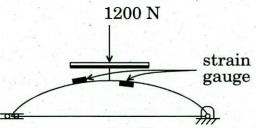
(C) Arm of 3 DOF manipulator is shown in the figure below. Joints 1 and 2 are perpendicular to each other and joints 2 and 3 are parallel. All joints are shown at their zero location and positive senses of the joint angles are indicated. Assign link frames {0} to {4} for the arm such that {0} represents frame {S} and {4} represents {T}. Make a table of D-H parameters and derive all the transformation matrices relating {0}, {1}, {2} and {3} frames.
